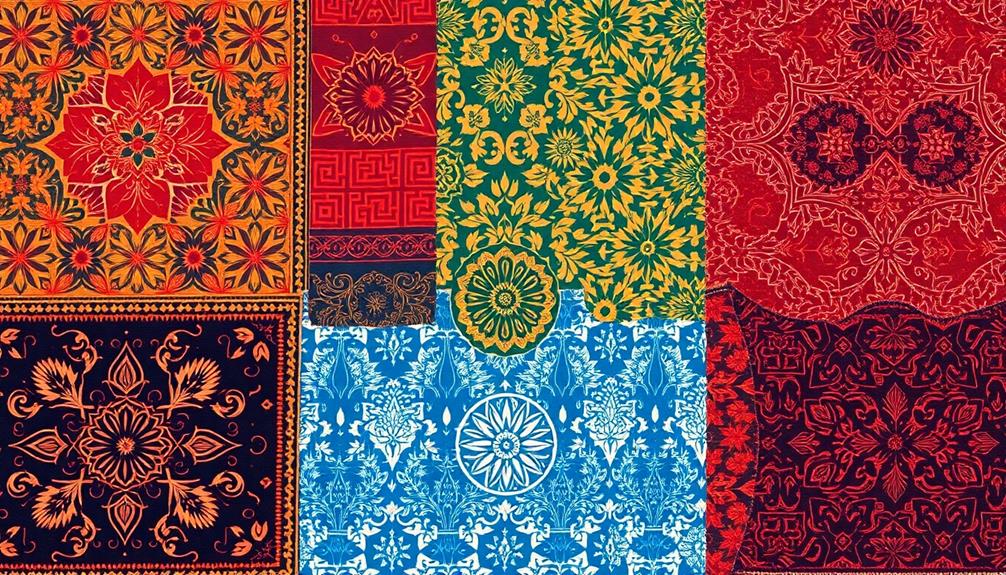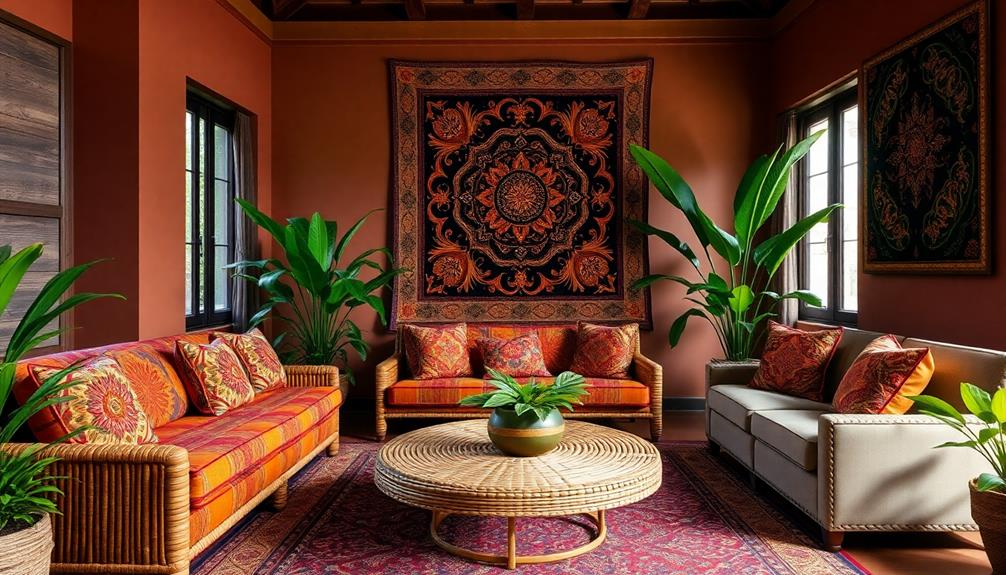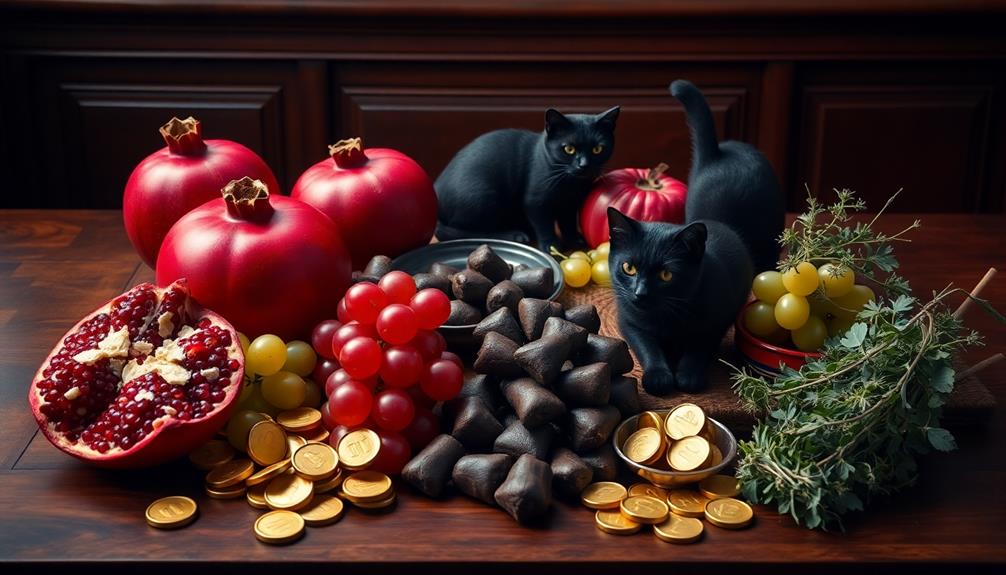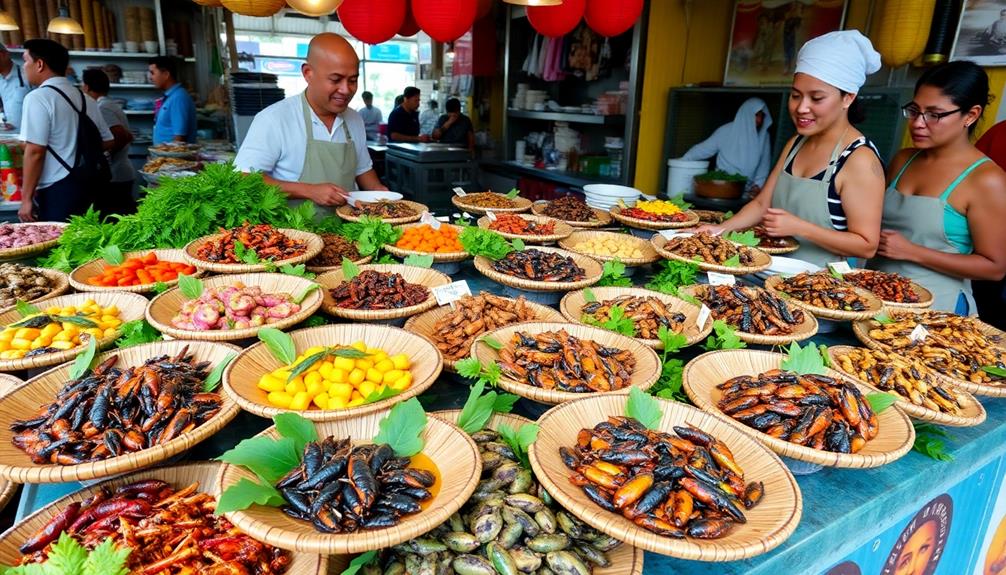Transform your space with unique batik patterns that carry deep meanings and cultural significance. For instance, the Batik Parang symbolizes resilience, while the Batik Mega Mendung promotes tranquility. You can create a calming atmosphere in your home with Batik Kawung, reflecting balance and purity. Using designs like Batik Sidomukti can add a touch of prosperity to your ceremonies, while the nurturing Batik Truntum enhances warmth in your living spaces. By thoughtfully incorporating these symbols, you enrich your decor and tell a beautiful story. There's plenty more to explore about how these stunning patterns can elevate your environment.
Key Takeaways
- Incorporate Batik Kawung in meditation spaces for promoting purity, balance, and self-control, enhancing your mindfulness practice.
- Use Batik Mega Mendung in living rooms to create a calming atmosphere, reflecting tranquility with its cloud-like designs.
- Display Batik Parang in workspaces to inspire resilience and perseverance, fostering a determined mindset during tasks.
- Choose Batik Sidomukti for wedding decor to symbolize prosperity and honor, adding a culturally rich touch to celebrations.
- Add Batik Truntum through cushions or throws to nurture a loving atmosphere, infusing warmth and comfort into your home.
Cultural Significance of Batik

Batik is more than just a fabric; it's a vibrant expression of Indonesian culture and identity. Recognized by UNESCO as a Masterpiece of the Oral and Intangible Heritage of Humanity, batik embodies the essence of cultural heritage. Each piece features symbolic motifs that convey deep meanings, reflecting the beliefs and values of Indonesian society.
You'll find that Javanese batik, in particular, holds a special place in traditional events, from weddings to ceremonial gatherings, showcasing the rich tapestry of Indonesian culture. Additionally, the intricate designs often complement other cultural elements, such as the unique artistic expressions found in Indonesian decor masks.
The intricate designs aren't merely decorative; they tell stories, capturing historical narratives and personal experiences. You might notice that certain patterns, like "Parang," were originally reserved for royalty, highlighting the fabric's connection to social status and identity.
Through the art of wax-resist dyeing, artisans create stunning pieces that resonate with spirituality and moral lessons. As you explore batik, you'll appreciate how it symbolizes national pride and cultural diversity, making it an essential part of Indonesia's identity.
Embracing batik goes beyond mere aesthetics; it connects you to the vibrant history and traditions that shape Indonesian culture.
Types of Batik Patterns
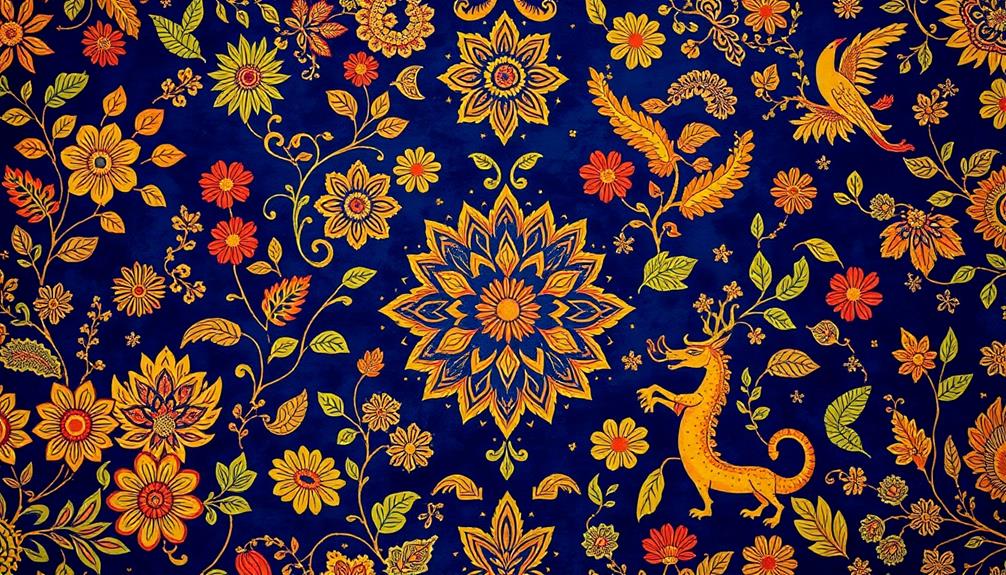
When you explore the types of batik patterns, you'll discover each one carries its own unique meaning and cultural significance.
For instance, Batik Parang represents resilience, while Batik Mega Mendung embodies patience.
Many of these patterns, like those found in traditional artistry, reflect the rich heritage of Indonesian culture.
Understanding these patterns can deepen your appreciation for the art and the stories woven into each piece.
Cultural Significance Explained
Among the rich tapestry of Indonesian culture, batik patterns serve as a profound medium for storytelling and self-expression. Each batik motif carries deep cultural significance, reflecting the values and beliefs of Indonesian society.
For instance, Batik Parang, with its wave-like designs, symbolizes perseverance and resilience, essential traits in facing life's challenges. In addition to their symbolic meanings, these patterns can be beautifully integrated into various decor elements, like Indonesian decorative pillows, enhancing both comfort and aesthetic appeal.
In contrast, the Batik Kawung pattern embodies purity, balance, and self-control, drawing inspiration from the sugar palm fruit. You might also find Batik Mega Mendung, which resembles clouds, representing patience and calmness through its seven color gradations symbolizing the seven layers of the sky.
On the other hand, Batik Sidomukti is often associated with prosperity and glory, making it a significant choice during traditional Javanese ceremonies.
The Batik Truntum, characterized by floral designs, symbolizes nurturing love that grows anew, making it popular for romantic occasions. Certain patterns, like Batik Sidoluhur, are traditionally reserved for brides, symbolizing honor and dignity during weddings.
Each design encapsulates an aspect of Indonesian cultural heritage, revealing the intricate connection between batik and the country's vibrant rituals.
Unique Patterns and Meanings
Delving into the world of batik reveals a stunning array of unique patterns, each imbued with distinct meanings that reflect Indonesia's rich heritage.
Batik patterns aren't just decorative; they tell stories through their symbolic imagery, much like the intricate designs found in Indonesian decor masks, which also embody cultural significance and craftsmanship.
For example, Batik Parang, with its wave-like design, symbolizes perseverance and resilience. Variations like Parang Barong are traditionally reserved for the royal family.
Another remarkable batik motif is Batik Mega Mendung, which resembles clouds and represents patience and calmness. Its seven color gradations signify the layers of the sky, reflecting tranquility.
Commonly worn at Javanese weddings, Batik Sidomukti embodies continuous glory and prosperity with its natural brown hues.
One of the oldest patterns, Batik Kawung, shaped like sugar palm fruit, signifies self-control and balance—virtues of courage and justice.
Finally, Batik Truntum, focused on floral designs, symbolizes nurturing love, suggesting that love can bloom anew like a cared-for flower.
These traditional batik tulis patterns from Central Java showcase the depth of meaning behind each design, allowing you to transform your space while honoring Indonesia's cultural heritage through both intricate designs and storytelling.
Meanings Behind Batik Designs
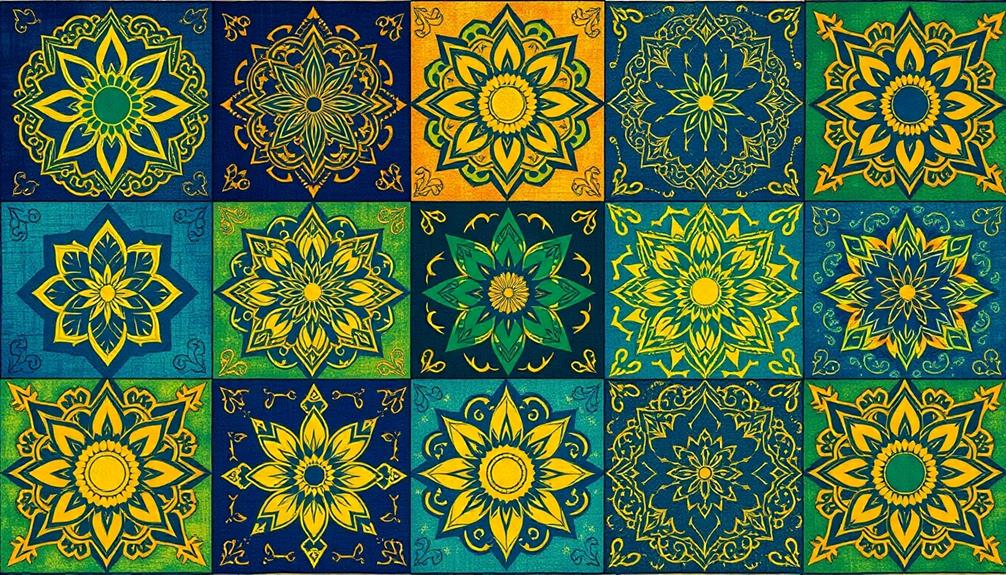
When you explore batik designs, you'll find that each pattern is rich with cultural significance.
Traditional Indonesian housing, such as Rumah Adat, often incorporates similar motifs that reflect values and beliefs.
The colors and unique regional motifs not only enhance their beauty but also convey deep symbolism, reflecting values and beliefs.
Understanding these meanings can deepen your appreciation for this traditional art form.
Cultural Significance of Patterns
Batik patterns are more than just beautiful designs; they embody rich cultural stories and values that resonate deeply within Indonesian society. Each batik design carries significant meanings, reflecting the beliefs and aspirations of its people.
For instance, the Batik Parang design symbolizes perseverance, inspiring you to embrace challenges head-on. The incorporation of these patterns can also complement natural materials and earth tones prevalent in Balinese interior design.
The Batik Kawung, resembling the sugar palm fruit, speaks to self-control, balance, courage, and justice—qualities revered by leaders and dignitaries throughout history.
Meanwhile, the Batik Mega Mendung, with its soft, cloud-like patterns, represents patience and calmness, featuring seven color gradations that symbolize the seven layers of the sky. This design encourages you to find tranquility in life's storms.
The Batik Sidoluhur, often present at Javanese weddings, signifies honor and dignity, embodying prayers for health and virtue during the marriage ceremony.
These batik motifs not only tell stories but also serve as a medium for personal expression. By incorporating these designs into your space, you connect with Indonesian heritage, appreciating the cultural significance behind each pattern while enhancing your own identity.
Symbolism in Colors
Colors in batik are more than just visual elements; they convey deep meanings and emotions that enhance the storytelling aspect of the designs. The vibrant batik colors you see often come from natural ingredients, each carrying unique color symbolism. For instance, blue symbolizes calmness and tranquility, while red embodies courage and passion. Traditional shades like beige, brown, and black hold significant meanings as well, with black representing power and elegance.
In the context of traditional Indonesian style home decor, these colors can beautifully complement the intricate carvings and natural materials that define the aesthetic.
The Kawung pattern, characterized by its circular motifs, uses natural colors to convey purity and harmony, reflecting the wearer's character and emotional state. You'll also notice gold leaf or dust incorporated into batik for special occasions, symbolizing wealth and luxury, especially in ceremonial clothing.
In regions like Pekalongan, brighter colors often signify joy and festivity, influenced by local celebrations and cultural expressions.
When you choose batik with specific colors, you're not just selecting a design; you're embracing a rich tapestry of meanings that resonate with your personal story and cultural heritage. Each color in batik enriches your space, inviting deeper connections and reflections.
Unique Regional Motifs
Exploring the diverse regional motifs in batik reveals a rich tapestry of meanings that are deeply rooted in Indonesia's culture and history. Each batik pattern showcases unique motifs that reflect local traditions and values. For instance, the Batik Parang symbolizes resilience and strength, often used in royal attire. In contrast, the Batik Mega Mendung features cloud-like designs that embody patience and calmness, with its seven color gradations representing the seven layers of the sky.
You'll also find the Batik Kawung, one of the oldest patterns, shaped like sugar palm fruit. This design represents self-control and balance and has been favored by leaders throughout history. In Javanese weddings, Batik Sidomukti is commonly worn, marked by natural brown hues that signify continuous glory and prosperity.
Here's a quick overview of some unique motifs:
| Motif | Meaning |
|---|---|
| Batik Parang | Resilience and strength |
| Batik Mega Mendung | Patience and calmness |
| Batik Kawung | Self-control and balance |
These wax-resist designs not only beautify your space but also connect you to Indonesia's rich heritage.
Historical Context of Batik
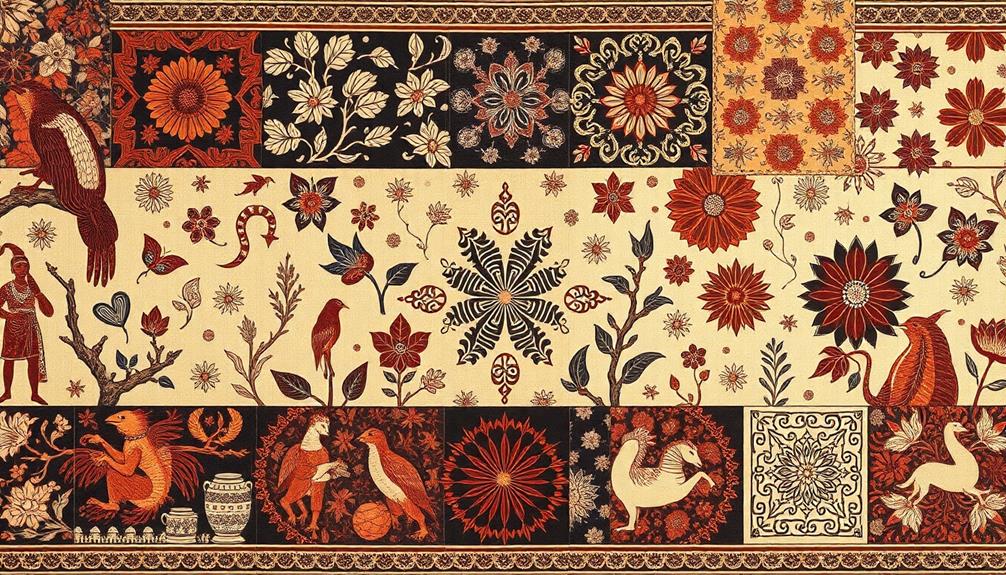
The rich tapestry of batik's history reveals its deep roots in ancient civilizations, tracing back over 2,000 years in regions like Africa, India, and Sri Lanka. As you explore batik patterns, you'll discover that their significance extends far beyond mere aesthetics.
The earliest written reference to batik appears in a Dutch bill of lading from 1641, highlighting its importance in trade and cultural exchange. Additionally, the traditional Indonesian housing style, known as "Rumah Adat," showcases the integration of cultural expressions, much like batik, reflecting the diverse heritage of the region traditional housing designs.
During the Majapahit kingdom, batik evolved into a crucial part of Javanese culture and identity. Certain batik patterns were reserved exclusively for royalty, reflecting social status and cultural hierarchy within Indonesian society.
These designs weren't just for show; they carried rich narratives tied to life journeys, community stories, and cultural legacies.
Craftsmanship and Techniques
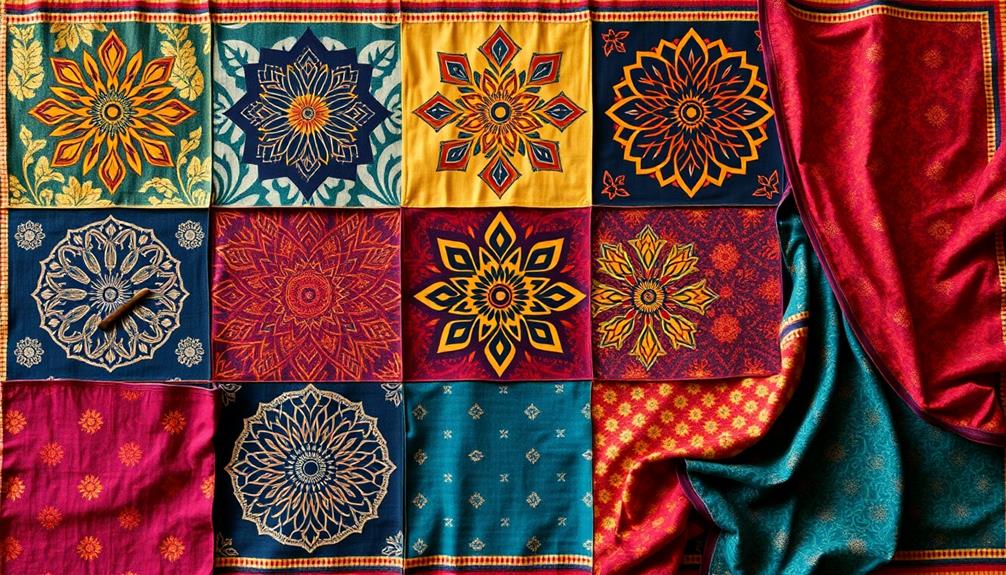
Batik craftsmanship showcases a remarkable blend of artistry and technique, reflecting the cultural narratives embedded in each design. This labor-intensive process involves batik artists applying hot wax using a canting for detailed designs or copper stamps, known as cap, for larger patterns. These methods allow for intricate and uniform creations that capture the essence of traditional batik.
Incorporating traditional batik patterns into your decor can elevate any event, from weddings to festive celebrations.
The dyeing technique employed in batik is a wax-resist method that requires multiple stages. You'll see artisans washing, soaking, and dyeing the fabric, carefully removing the wax to reveal the final pattern.
Batik Tulis, the hand-drawn method, can take weeks to years to complete, highlighting the dedication and skill of each artisan. In contrast, Batik Cap offers faster production, making these beautiful patterns more accessible.
Preserving traditional batik techniques is essential for maintaining cultural heritage. Many artisans undergo rigorous training to master these intricate processes, ensuring the continuation of this age-old art form.
As you explore batik patterns, you'll appreciate not only the beauty of each design but also the craftsmanship and stories that breathe life into them.
Batik in Modern Decor
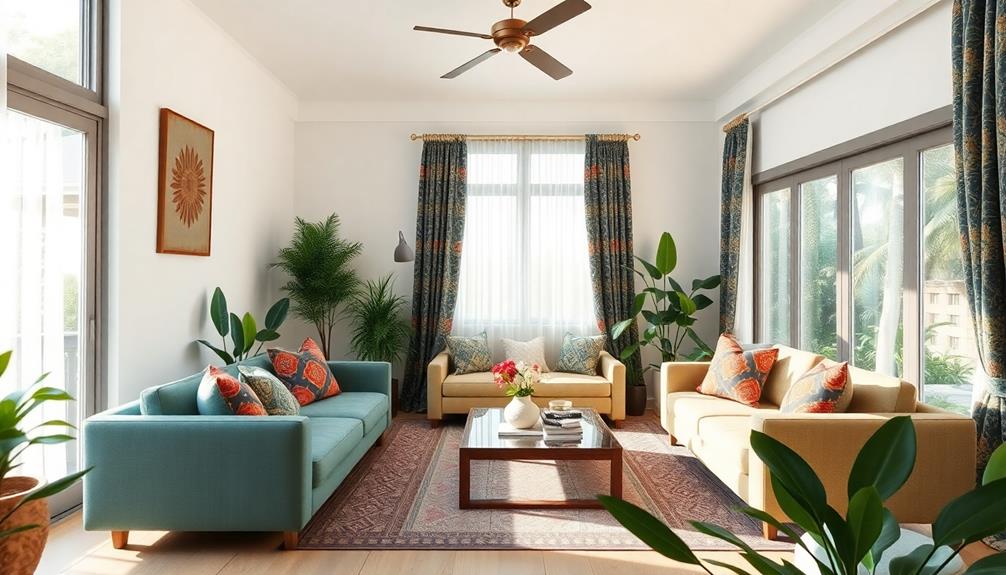
Brightly colored batik cushions can transform your living space, adding a touch of cultural heritage to modern decor. These batik patterns serve as striking accent pieces, enhancing the aesthetic appeal of any room with their intricate designs and vibrant hues.
By incorporating batik textiles, such as cushions or curtains, you can celebrate Indonesian cultural heritage while infusing a unique charm into your contemporary interiors. Many interior design shops in Bali, such as those that focus on sustainable craftsmanship, offer stunning batik-inspired decor options that can elevate your space even further.
Modern designers often skillfully blend traditional batik motifs with contemporary styles, creating innovative pieces that resonate with younger audiences. This approach reflects a growing interest in cultural textiles and artisanal craftsmanship.
Whether your style is bohemian or minimalist, batik can be effectively used across various design aesthetics, showcasing its versatility.
One of the best ways to utilize batik in your decor is by creating a focal point in your space. Thoughtful selection of color and pattern can draw attention to specific areas, harmonizing with other elements in the room.
Incorporating Batik in Your Space

Your living space can truly benefit from the unique charm of batik patterns, offering a cultural touch that transforms the atmosphere. By incorporating batik, you not only beautify your space but also infuse it with deep symbolism. Here are some ways to do it:
- Batik Kawung: Use this pattern in meditation areas to symbolize self-control and balance, promoting a serene environment.
- Batik Mega Mendung: Incorporate this calming design in your living room or bedroom to enhance relaxation with its cloud-like motifs.
- Batik Parang: Feature this resilient pattern in your office as wall art or upholstery to inspire determination and perseverance during work.
- Batik Sidoluhur: Elevate wedding or celebration decor with this symbolic design, representing honor and virtue, traditionally worn by brides.
For an extra touch of warmth, consider adding Batik Truntum through cushions or throws, nurturing a loving atmosphere at home.
Frequently Asked Questions
What Does the Batik Symbolize?
Batik symbolizes various cultural values and beliefs, reflecting resilience, balance, patience, and prosperity. Each intricate pattern tells a unique story, connecting you to deeper meanings within Indonesian heritage and enriching your appreciation for traditional art.
What Are the Patterns of Batik?
Imagine wearing a batik shirt featuring the Kawung pattern; it's not just a design. Batik patterns like Parang and Mega Mendung tell stories of resilience, purity, and patience, enriching your understanding of Indonesian culture.
What Is the Most Famous Batik Pattern?
The most famous batik pattern is Batik Parang. Its wave-like design symbolizes perseverance and resilience, often linked to royalty. When you see it, you'll appreciate its rich cultural significance and beauty.
What Are the 5 Major Types of Batik Design?
You'll find five major types of batik design: Batik Tulis, Batik Cap, Batik Lukis, Batik Pesisir, and Batik Belanda. Each type showcases unique techniques and cultural influences, reflecting the rich heritage of batik artistry.
Conclusion
By embracing these seven symbolic batik patterns, you're not just decorating your space; you're weaving a rich tapestry of culture and history into your home. Each design tells a story, inviting warmth and depth that few other decor can match. So, why settle for ordinary when you can transform your surroundings into a vibrant reflection of artistry and tradition? Let the beauty of batik inspire your creativity and elevate your environment to new heights.
